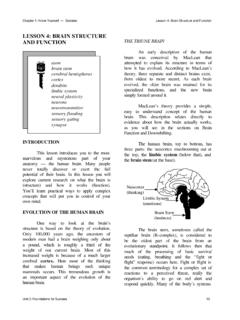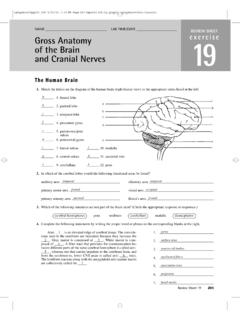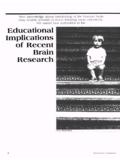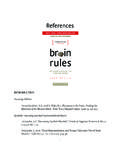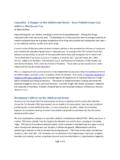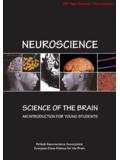Transcription of Acupressure Effects on Brain Function - i-leap.org
1 1 Acupressure Effects on Brain Function By Dr. Charles T. Krebs Melbourne Applied Physiology Box 173 Addington-Creswick Road Learmonth , Victoria 3352 Acupuncture or Acupressure therapy consists of either stimulating or dispersing the flow of energy, called Ch i by the Chinese, by activation of specific acupoints on the surface of the body. The acupoints have been shown to have a unique histological microstructure and have been accurately mapped using electrical detection because they have been found to be null points or points of least electrical resistance on the surface of the body1-2. This electrical mapping is very highly correlated with Chinese maps of these same points3-8. The Chinese propose that Ch i energy is a dynamic force in constant flux that circulates throughout the body but that follows specific pathways and specific rules, and directly affects various specific physiological functions9-12.
2 In animal studies, Zhongfang et showed that the stimulation of specific acupoints using electro-acupuncture could activate or inhibit the electrical activity of specific neurons within the amygdaloid nucleus, the subconscious emotional control center of the Brain , resulting in increasing and decreasing rates of neuronal discharge. They also found that electro-acupuncture stimulation of different acupoints caused either consistent but different responses in the discharge rate of a single group of neurons in the amygdala or no effect on these neurons. Thus stimulation of specific individual points caused highly specific patterns of discharge in this deep Brain structure. They also found that stimulation of sham points produced no detectable change in neuronal firing rates in the amygdala. Traditional acupuncture techniques are stated to be helpful for strengthening cerebral Function and improving intelligence14.
3 In human subjects, Abad-Alegria et al. demonstrated that acupuncture stimulation of the acupoint Heart 7 produced long-lasting increases in the P300 wave, a late evoked EEG potential that has been associated with cognitive activities15. Stimulation of another acupoint, Large Intestine 4 , did not change the P300 wave, suggesting this cortical response to acupoint stimulation is highly specific. A recent study showed that a common acupuncture technique eased blood pressure by stimulating specific receptors in the central nervous system16, while Bucinskaite et al17 found that electro-acupuncture increased levels of various neuropeptides in the rat Brain , with significant increases in the hippocampus, a limbic structure directly involved in short-term memory. Also, a decrease of neuropeptide Y along with a decrease in the Comprehensive Psychopathological Rating Scale, CPRS, for depression sub-scale score was noted in five out of six patients suffering from major depression who were treated with electroacupuncture in a pilot study by Pohl and Nordin18.
4 Using f-MRI scanning researchers have shown that specific acupoint stimulation caused specific patterns of neuronal activity in the cerebral cortex that correlated with traditional Chinese Medicine s treatment for visual disorders 19-20. Even though the acupoints were on the side of the little toe and side of the foot, stimulation of these points activated specific and unique areas of the occipital cortex. Each of the acupoints stimulated is associated in 2 traditional Chinese Medicine with a specific type of eye or vision disorder, providing strong correlation between acupoint stimulation and relevant cortical activation. Another f-MRI study showed needle acupuncture stimulation of Large Intestine 4, caused activation of the limbic system and subcortical structures associated with reward and punishment and emotional and behavioral regulation21.
5 Again specific acupoints activated highly specific limbic and subcortical areas. In these studies as in the study of Zhongfang et , stimulation of non-acupuncture sham points had no effect on cortical or subcortical activation. Recent f-MRI studies substantiate the specificity of Brain area activation by specific acupoint stimulation, and lack of activation of the Brain by sham acupoint stimulation in human subjects. Pariente et demonstrated that acupuncture treatments produced real affects beyond placebo using a retractable needle so that the subjects did not know when they were receiving real or placebo treatments. Zhang et al. 23 showed that stimulation of acupoints on the same spinal segment activated unique and highly specific areas of the Brain , and that each point stimulated different Brain areas.
6 Several other studies have substantiated this specificity of acupoint stimulation with Brain areas 24-25 Yan et al. 26 demonstrated that acupuncture of Liver 3 and Large Intestine 4 each activated unique Brain areas relative to sham acupoints. Yan et al. concluded that these observations reveal acupuncture of specific acupoints induces unique patterns of Brain activity specific to each acupoint, and that these patterns may relate to the therapeutic Effects of acupuncture. For excellent reviews of the Effects and specificity of acupoint stimulation on Brain areas you are referred to Dhond et Acupressure Formatting: A unique concept in Applied Physiology using direct biofeedback from muscle monitoring or kinesiology is termed Acupressure formatting. 28 An Acupressure format is a combination of acupoints that when stimulated at the same time creates a unique energetic signature for various structures and functions in the Brain .
7 Information about the levels of stress in these Brain structures can then be identified by direct muscle biofeedback or kinesiology, and then various Acupressure treatments may be employed to release this energetic stress with normalization of neural Function . Although there has been no external validation of activation of specific Brain structures via Acupressure formatting, two types of information provide practical and theoretical support for this technique. First of all, there is ample anecdotal evidence to demonstrate that specific Brain functions demonstrating stress by Acupressure formatting changed significantly following treatment. Secondly, recent scientific studies (as discussed above) have shown that acupuncture stimulation of specific acupoints results in highly specific activation of specific Brain areas.
8 For instance, people may have hypersensitivity to normal levels of light, often needing to wear sunglasses whenever outside as normal levels of daylight are uncomfortable for them. For these light sensitive people, Acupressure formatting specifically for the pupillary control mechanisms of the amygdala and posterior hypothalamic nuclei consistently show stress via kinesiology, but not with people that do not have this light sensitivity. Further, when these formats are activated, and followed by Acupressure corrections for the perceived stress , both the Acupressure formatting for the pupillary control areas no longer showed stress to be present, and the hypersensitivity to light disappeared. These people 3 now respond normally to light levels no longer needing their sunglasses, indicating that the Function of this basal visual mechanism of pupillary control has indeed been normalized.
9 Likewise, Digit Span, a standard measure of auditory short-term memory is highly dependent upon integrated hippocampal Function . When people demonstrate deficit Digit Span, stress is found in the hippocampus and other memory areas of the Brain via Acupressure formatting and kinesiology. Once these stresses are resolved by various Acupressure techniques, people s auditory short-term memories reproducibly improve to normal or in some cases to better than normal as measured on standard psychological This is in spite of the fact that millions of Digit Span tests performed by psychologists have shown that Digit Span does not improve spontaneously, and basically is stable over your In a similar way, even highly complex functions like reading comprehension show measurable improvements after Acupressure formatting to access stress caused by attempting this activity, followed by Acupressure Thus, even though the exact nature of the activation of cortical and subcortical neural substrates via Acupressure formatting is not understood.
10 Reproducible observable and measurable normalization of the functions directly reliant upon these neural substrates strongly suggest that these specific Brain structures are indeed targeted by Acupressure formatting. There have also been direct observations of the effect of Acupressure formatting on physiological Function . An Austrian anesthesiologist, Dr. Sylvester Klaunzer, who has taken the two-year LEAP Integrated Training associated with the University of Salzburg in Saalfelden, Austria, recently made the following observation. He was working in intensive care and a cardiac patient had atrial fibrillation and variable blood pressure that was not responding to drugs and the patient was in a serious condition. Because the drugs were not working, Dr. Klaunzer just entered the Acupressure format for the amygdala and then applied Acupressure to these points.
